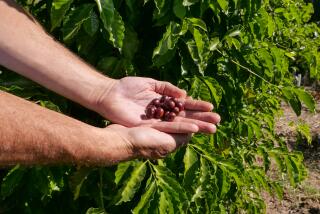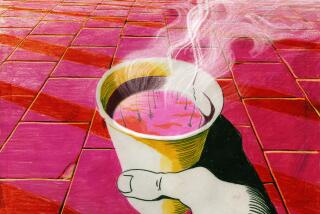The Coffee Revolution : Bean Lore : Coffee: Where it came from, what’s in it and how it gets this way.
The coffee plant, Coffea arabica , is native to Ethiopia. It has relatives in various widely separated areas of Africa and Madagascar, which makes botanists suspect the original coffee species once grew throughout Africa but disappeared in most places during the Ice Age. Apart from Coffea arabica , the only plant of the family used for beverage-making is Coffea canephora var. robusta , native to the Congo and Angola.
C. arabica is the basis of all premium coffees. It’s an arid-climate plant, a straggly bush even when healthy and always ready to shrivel so it can survive a drought. Like the wine grape, it produces a drink whose flavor is greatly affected by soil and climate.
The robusta plant, by contrast, is a strong, fast-growing jungle plant, chiefly grown in the Ivory Coast, the Philippines, Zaire and Java (the famous Java coffee of decades ago, however, was arabica). Robusta, which has been used only since 1940, is primarily a source of caffeine--its flavor is acid and its aroma is coarse, like rank hay. It is much used in canned and particularly in freeze-dried coffee.
Arabica can be grown only within 25 degrees of the Equator because if the temperature changes more than 20 degrees a day, production plummets. Preferably it is grown in highlands where temperatures don’t get above 70 degrees; the better coffees nearly all come from elevations between 4,500 and 8,000 feet.
The reason is that with the lower temperatures and the longer ripening season, flavor elements become more complex and bitterness is less pronounced. High-grown coffees are also as much as 40% lower in caffeine. However, high-grown coffee is relatively expensive. Unlike coffee grown in lower elevations, the beans ripen unevenly and can’t be cheaply harvested all at once; a lot of hand labor is inevitable.
The fruits of the coffee bush (called “berries”) are gathered when red. Growers traditionally remove the red husk surrounding the bean by letting the berries dry in the sun and then rubbing them off, but the more modern method is “washing”--scraping the berries and soaking them in water so the husks float away. Washed beans ferment slightly in the water, giving a clean, acid flavor to the coffee made from them; unwashed beans are less acid and have a more fruity, earthy taste. The intensity of flavor of coffee has to do with the density, not the size, of the bean.
Caffeine--1,3-7 trimethylxanthine--is the most famous ingredient in coffee, but coffee also contains the related stimulant chemicals theobromine (also found in chocolate) and theophylline (also found in tea). Coffee is not the only source of caffeine, however--it’s present in the cola nut and the South American teas mate and guarana. Caffeine is an antifungal agent and sterilizes certain insects, and is assumed to be part of the plant’s defense mechanism.
Some facts about caffeine: 90% of the caffeine in ground coffee is extracted in the first 60 seconds of contact with hot water. Some caffeine evaporates into the air during roasting, which is one reason coffee roasters are careful to send roasting smoke up through chimneys--otherwise workers would have coffee overdoses all day long. A 1977 study found detectable levels of caffeine, coming from coffee-roasting plants, in New York City air.
Roasting is a drastic process for the coffee bean, which swells and almost pops like popcorn. Complex chemical changes take place in a matter of seconds. Moisture is reduced, protein molecules are burst apart, sugars and aromatic compounds are created.
The main effect is the creation of roasted flavors, but there are many others. The longer the bean is roasted, the more the acid flavors retreat and the more sweet and charcoalized flavors appear. When a bean is roasted until very dark and oily, over the next few days the bean will tend to reabsorb the oil, but when it is roasted not quite to oiliness, oils will appear on the surface over the next few days.
More to Read
Sign up for Essential California
The most important California stories and recommendations in your inbox every morning.
You may occasionally receive promotional content from the Los Angeles Times.










